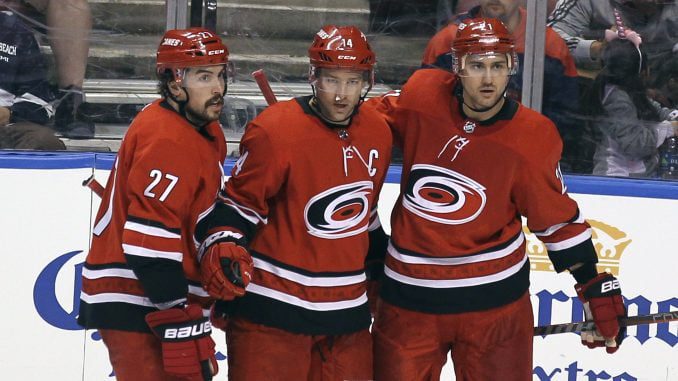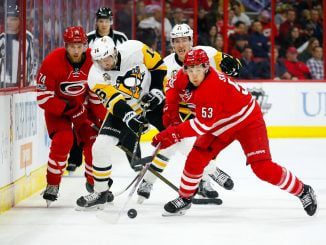
RALEIGH — It’s late February and the Hurricanes are in playoff contention. Carolina is currently in the second wild-card spot based on points with 70 in 61 games, though Columbus is just one point back with two games in hand.
After that, some separation is happening. The Sabres, 3-5-2 in their last 10, are at 64 points and looking like they could be deadline sellers, while Philadelphia’s hot run has come to an end with two straight losses. The Flyers are seven points behind Carolina.
This week’s Category 5 — with lots of help from hockey-reference.com — looks at the team’s newest addition having a surprisingly sustainable start with the Hurricanes, forward ice time, the captain’s big season, February goaltending, and some fancy stats.
Category 1: The fact Nino Niederreiter has nine goals in his first 15 games with Carolina speaks for itself. Even in their wildest dreams, GM Don Waddell and the Hurricanes’ brain trust couldn’t have envisioned the Swiss forward making this much of an impact.
That production would put Niederreiter on pace for a 49-goal season when projected out over an 82-game campaign. That’s not a totally (Wallace Shawn voice) inconceivable number for a top-line forward, but given that Niederreiter’s career best is 25 goals in a season it seems unsustainable.
The good news is it’s not like Niederreiter is just getting a bunch of puck luck — his PDO is 100.7 and he’s generating a ton of chances. Niederreiter already has 53 shots on goals since coming to the Hurricanes, an average of 3.53 per game. Because of that, his shooting percentage is a not-all-that-outrageous 17 percent — just a touch better than the 16.1 percent he shot in 2014-15 when he scored 24 goals. He has a 12.2 shooting percentage for his career.
The opportunity to play on the top line — with a center like Sebastian Aho, who generates a ton of points for his running mates — and the minutes that come with it are also part of it. He is playing 18:31 a night since coming to Carolina compared to 14:49 in his five-plus seasons with the Wild.
Category 2: Speaking of ice time, Aho is getting a ton of it. The Hurricanes’ No. 1 center is now averaging more than 20 minutes a game (20:10) after he played 26:25 in Tuesday’s 2-1 loss to the Rangers and 22:34 in the 4-3 win Thursday in Florida.
No one is likely catching the 24:18 Rod Brind’Amour averaged in 2005-06 — he holds the top six spots in average ice time for a forward since the team relocated to North Carolina — but Aho could top Eric Staal’s 20:17 from 2013-14 for the most in six seasons among Hurricanes forwards. The eventual return of Jordan Staal from injury will cut into Aho’s minutes — Carolina desperately needs Staal in the faceoff circle, and Aho’s averaged more than 21 minutes a night since the start of December — but it’s hard to see the team being successful without Aho logging at least 20 minutes a night.
Category 3: Justin Williams’ two goals Thursday — one a deflection off his face, of all things, the other the go-ahead power play goal in the third — gives him 17 on the season, topping his goal output from last year (16) in his first season back in Carolina. Williams’ leadership abilities certainly weren’t in doubt, but his production at age 37 is a huge bonus.
Only three other players in franchise history have scored more than 15 goals in their age 37 season or older: Ron Francis did it twice, scoring 27 at age 38 and 22 the following year; Ray Whitney had 21 goals in 2009-10 at 37; and Brind’Amour also did it twice, scoring 19 in 2007-08 at 37 and 16 the following year.
I’d be remiss to not mention Mr. Hockey — Gordie Howe had 15 goals and 26 assists for the Whalers in his final NHL season following the WHA merger in 1979-80. He’s was 51.
Category 4: How’s this for some February goaltending: The Hurricanes are 8-3-0 this month, and Curtis McElhinney and Petr Mrazek have been sensational. McElhinney is 4-1 with a 1.80 goals-against average and .942 save percentage, while Mrazek is right behind him at 4-2 with a 2.03 GAA and .929 S%.
And you could argue Mrazek’s been the better of the two. The Czech goalie — who was sensational Thursday in Sunrise — has allowed just six even-strength goals this month, compared to McElhinney’s nine. Most of the damage done against Mrazek has been on special teams, where he’s allowed five goals on the penalty kill plus a shorthanded tally. McElhinney is the only goalie in the league this month with more than four decisions and no goals allowed on special teams.
That’s really been the difference between the two goalies this year. Mrazek has given up 22 goals when Carolina is down a man (.788 save percentage) plus five shorthanded goals allowed, and McElhinney’s shorthanded save percentage is .866 — he’s given up 11 goals on the PK and one shorthanded. The tandem’s even-strength save percentage is practically identical — McElhinney is .926, Mrazek is .923.
Category 5: The Hurricanes have been possession monsters all season. After Thursday’s win, the team has exactly 4,000 Corsi For attempts on the campaign, the most in the NHL. Carolina’s Corsi For percentage on the season is 55.3, a full percentage point ahead of Vegas and San Jose, who are tied for second.
So that makes this next stat incredibly curious: Carolina is 5-11-4 when they have a Corsi For percentage of 60 percent or better this season. Some of that can be attributed to a pushing to generate more attempts on net when they’re behind, and in 10 of those games, the Hurricanes scored just once. Another time, they were shut out.
Then there’s the flip side: Carolina’s six-worst Corsi For games — all had 42 percent of worse — were wins.



